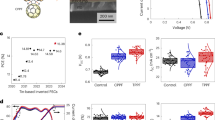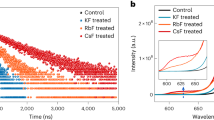Abstract
Photovoltaics based on tin halide perovskites have not yet benefited from the same intensive research effort that has propelled lead perovskite photovoltaics to >20% power conversion efficiency, due to the susceptibility of tin perovskites to oxidation, the low energy of defect formation and the difficultly in forming pinhole-free films. Here we report CsSnI3 perovskite photovoltaic devices without a hole-selective interfacial layer that exhibit a stability ∼10 times greater than devices with the same architecture using methylammonium lead iodide perovskite, and the highest efficiency to date for a CsSnI3 photovoltaic: 3.56%. The latter largely results from a high device fill factor, achieved using a strategy that removes the need for an electron-blocking layer or an additional processing step to minimize the pinhole density in the perovskite film, based on co-depositing the perovskite precursors with SnCl2. These two findings raise the prospect that this class of lead-free perovskite photovoltaic may yet prove viable for applications.
This is a preview of subscription content, access via your institution
Access options
Subscribe to this journal
Receive 12 digital issues and online access to articles
$119.00 per year
only $9.92 per issue
Buy this article
- Purchase on Springer Link
- Instant access to full article PDF
Prices may be subject to local taxes which are calculated during checkout







Similar content being viewed by others
References
Kojima, A., Teshima, K., Shirai, Y. & Miyasaka, T. Organometal halide perovskites as visible-light sensitizers for photovoltaic cells. J. Am. Chem. Soc. 131, 6050–6051 (2009).
Xu, T., Chen, L., Guo, Z. & Ma, T. Strategic improvement of the long-term stability of perovskite materials and perovskite solar cells. Phys. Chem. Chem. Phys. 18, 27026–27050 (2016).
Pyykkö, P. Relativistic effects in structural chemistry. Chem. Rev. 88, 563–594 (1988).
Boix, P. P., Agarwala, S., Koh, T. M., Mathews, N. & Mhaisalkar, S. G. Perovskite solar cells: beyond methylammonium lead iodide. J. Phys. Chem. Lett. 6, 898–907 (2015).
Noel, N. K. et al. Lead-free organic-inorganic tin halide perovskites for photovoltaic applications. Energy Environ. Sci. 7, 3061–3068 (2014).
Hao, F., Stoumpos, C. C., Cao, D. H., Chang, R. P. H. & Kanatzidis, M. G. Lead-free solid-state organic–inorganic halide perovskite solar cells. Nat. Photon. 8, 489–494 (2014).
Xu, P., Chen, S., Xiang, H.-J., Gong, X.-G. & Wei, S.-H. Influence of defects and synthesis conditions on the photovoltaic performance of perovskite semiconductor CsSnI3 . Chem. Mater. 26, 6068–6072 (2014).
Kumar, M. H. et al. Lead-free halide perovskite solar cells with high photocurrents realized through vacancy modulation. Adv. Mater. 26, 7122–7127 (2014).
Yokoyama, T. et al. Overcoming short-circuit in lead-free CH3NH3SnI3 perovskite solar cells via kinetically controlled gas–solid reaction film fabrication process. J. Phys. Chem. Lett. 7, 776–782 (2016).
Shockley, W. & Queisser, H. J. Detailed balance limit of efficiency of p–n junction solar cells. J. Appl. Phys. 32, 510–519 (1961).
Chung, I. et al. CsSnI3: semiconductor or metal? High electrical conductivity and strong near-infrared photoluminescence from a single material. High hole mobility and phase-transitions. J. Am. Chem. Soc. 134, 8579–8587 (2012).
Huang, L. & Lambrecht, W. R. L. Electronic band structure, phonons, and exciton binding energies of halide perovskites CsSnCl3, CsSnBr3, and CsSnI3 . Phys. Rev. B 88, 165203 (2013).
Chen, Z. et al. Photoluminescence study of polycrystalline CsSnI3 thin films: determination of exciton binding energy. J. Lumin. 132, 345–349 (2012).
Zhang, J. et al. Energy barrier at the N719-dye/CsSnI3 interface for photogenerated holes in dye-sensitized solar cells. Sci. Rep. 4, 6954 (2014).
Stoumpos, C. C., Malliakas, C. D. & Kanatzidis, M. G. Semiconducting tin and lead iodide perovskites with organic cations: phase transitions, high mobilities, and near-infrared photoluminescent properties. Inorg. Chem. 52, 9019–9038 (2013).
Hao, F. et al. Solvent-mediated crystallization of CH3NH3SnI3 films for heterojunction depleted perovskite solar cells. J. Am. Chem. Soc. 137, 11445–11452 (2015).
Sabba, D. et al. Impact of anionic Br- substitution on open circuit voltage in lead free perovskite (CsSnI3−xBrx) solar cells. J. Phys. Chem. C 119, 1763–1767 (2015).
Chen, Z., Wang, J. J., Ren, Y., Yu, C. & Shum, K. Schottky solar cells based on CsSnI3 thin-films. Appl. Phys. Lett. 101, 93901 (2012).
Marshall, K. P., Walton, R. I. & Hatton, R. A. Tin perovskite/fullerene planar layer photovoltaics: improving the efficiency and stability of lead-free devices. J. Mater. Chem. A 3, 11631–11640 (2015).
Koh, T. M. Formamidinium tin-based perovskite with low Eg for photovoltaic applications. J. Mater. Chem. A 3, 14996–15000 (2015).
Zhang, M. et al. Low-temperature processed solar cells with formamidinium tin halide perovskite/fullerene heterojunctions. Nano Res. 9, 1570–1577 (2016).
Werker, W. Die Kristallstruktur des Rb2SnI6 und Cs2SnI6 . Recl. Trav. Chim. Pay. 58, 257–258 (1939).
Lee, B. et al. Air-stable molecular semiconducting iodosalts for solar cell applications: Cs2SnI6 as a hole conductor. J. Am. Chem. Soc. 136, 15379–15385 (2014).
Xiao, Z., Zhou, Y., Hosono, H. & Kamiya, T. Intrinsic defects in a photovoltaic perovskite variant Cs2SnI6 . Phys. Chem. Chem. Phys. 17, 18900–18903 (2015).
Peedikakkandy, L. & Bhargava, P. Composition dependent optical, structural and photoluminescence characteristics of cesium tin halide perovskites. RSC Adv. 6, 19857–19860 (2016).
Shannon, R. D. Revised Effective ionic radii and systematic studies of interatomic distances in halides and chalcogenides. Acta Crystallogr. A A32, 751–767 (1976).
Moses, P. R. et al. X-ray photoelectron spectroscopy of alkylamine-silanes. Anal. Chem. 50, 576–585 (1978).
Alonzo, G. et al. Mössbauer, far-infrared, and XPS investigations of SnCl2 and SnCl4 introduced in polyconjugated monosubstituted acetylene matrices. Appl. Spectrosc. 49, 237–240 (1995).
Zhang, Y. et al. Flexible, hole transporting layer-free and stable CH3NH3PbI3/ PC61BM planar heterojunction perovskite solar cells. Org. Electron. 30, 281–288 (2016).
Chung, I., Lee, B., He, J., Chang, R. P. H. & Kanatzidis, M. G. All-solid-state dye-sensitized solar cells with high efficiency. Nature 485, 486–489 (2012).
Tyler, M. S., Nadeem, I. M. & Hatton, R. A. An electrode design rule for high performance top-illuminated organic photovoltaics. Mater. Horiz. 3, 348–354 (2016).
Yan, Y. Perovskite solar cells: high voltage from ordered fullerenes. Nat. Energy 1, 15007 (2016).
Shao, Y., Yuan, Y. & Huang, J. Correlation of energy disorder and open-circuit voltage in hybrid perovskite solar cells. Nat. Energy 1, 15001 (2016).
Saparov, B. et al. Thin-film deposition and characterization of a Sn-deficient perovskite derivative Cs2SnI6 . Chem. Mater. 28, 2315–2322 (2016).
Glen, T. S. et al. Dependence on material choice of degradation of organic solar cells following exposure to humid air. J. Polym. Sci. B 54, 216–224 (2016).
Acknowledgements
The authors would like to thank the United Kingdom Engineering and Physical Sciences Research Council (EPSRC) for funding (Grant numbers: EP/L505110/1 & EP/N009096/1). All data supporting this study are provided as Supplementary Information accompanying this paper.
Author information
Authors and Affiliations
Contributions
K.P.M. performed all of the experimental work. K.P.M., R.I.W. and R.A.H. conceived the experiments, analysed the results and wrote the paper. M.W. collected the XPS and UPS data and helped to analyse the results.
Corresponding author
Ethics declarations
Competing interests
The authors declare no competing financial interests.
Supplementary information
Supplementary Information
Supplementary Figures 1–14, Supplementary Tables 1–6, Supplementary Discussion. (PDF 1927 kb)
Rights and permissions
About this article
Cite this article
Marshall, K., Walker, M., Walton, R. et al. Enhanced stability and efficiency in hole-transport-layer-free CsSnI3 perovskite photovoltaics. Nat Energy 1, 16178 (2016). https://doi.org/10.1038/nenergy.2016.178
Received:
Accepted:
Published:
DOI: https://doi.org/10.1038/nenergy.2016.178
This article is cited by
-
An Absorber Enrichment Study and Implications on the Performance of Lead-Free CsSnI3 Perovskite Solar Cells (PSCs) Using One-Dimensional Solar Cell Capacitance Simulator (1D-SCAPS)
Brazilian Journal of Physics (2024)
-
First-principles calculations to investigate structural, optoelectronic and thermoelectric properties of Sn-based halide perovskites: CsSnCl3 and CH3NH3SnCl3
Journal of the Korean Ceramic Society (2024)
-
Challenges and strategies toward long-term stability of lead-free tin-based perovskite solar cells
Communications Materials (2022)
-
High-performance inorganic metal halide perovskite transistors
Nature Electronics (2022)
-
Nanorod-like nanocrystalline CsSnI3 and CNT composite thin film–based hybrid photodetector
Emergent Materials (2022)



